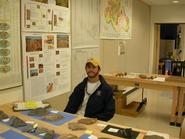
Timothy Fox '08 (Montclair, N.J.) is spending his summer in the lab with the good company of Neoproterozoic sedimentary rocks. He is working with Professor of Geology Eugene Domack studying glacial rocks from Namibia and East Greenland in the hopes of better understanding the implications of global ice covering episodes (glaciations) that have occurred in the past, and the associated effects on long-term climatic stability.
Fox's focus is on sedimentary rocks of glacial origin, which are, quite simply, "rocks made out of dirt," or glacial debris. The structure of these rocks allows the researcher to infer information about the dynamics of the glacier which created the rock, and the climatic conditions under which formation occurred. A geologist will find different compositions depending on where in the glacial cycle the rock was created.
Fox is using his rocks to find supporting evidence for the Snowball Earth theory. This theory propagates the idea of neoproterozoic glaciation, or that, between 710 and 640 million years ago, the earth went through several cycles of extensive low-latitude glaciation. The theory also suggests that the earth has, in its life-time, been through numerous cycles of freezing and heating. "Ice-house to hot-house," Fox calls it. The extreme climate fluctuation is important to study because it may throw light on global warming and our current climate stability.
The neoproterozoic continental arrangement placed Namibia and East Greenland on the same latitude, close to the equator. Since ice would have spread from the poles to the equator, Fox proposes to study samples from this equatorial region, the farthest ice spread. Other research has shown that there was ice in these regions, but Fox is interested in how much ice. "Did the whole earth freeze over or just 85% [of it]?"
Fox's summer is split into two parts. He spent the month of July in the lab analyzing rock samples from a previous excursion. He will then put together six rocks from each of his two sample sets into a representative group. This will be a teaching pack to be sent to other colleges and used in introductory geology courses. It will be an important resource, Fox explains, "for institutes who can't get out in the field." The funding for Fox's sample kit comes from the National Science Foundation Snowball Earth grant awarded to Domack.
In August, Fox headed to Namibia on a joint mapping and collecting mission. As a field assistant invited by Domack, Fox will join Domack, Hamilton geology student Mary Beth Day '07 and Paul Hoffman, the Harvard professor who came up with the Snowball Earth hypothesis. Although a rising junior, Fox already has plans to use the samples from this trip for his senior thesis, which he hopes will deal with the Snowball Earth theory.
Fox is enjoying his first summer of research. "I like working with samples and making this kit," he says. "I get to think, what kinds of questions would I ask if I'd never seen this before? What can I use, how can I convey this to them?"
- Lisbeth Redfield
Posted August 11, 2006
